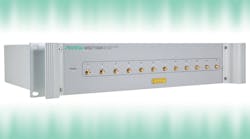This file type includes high resolution graphics and schematics when applicable.
Spectrum is invaluable and irreplaceable, so much so that monitoring signal activity is one way to help safeguard it. Ideally, spectrum monitoring can be performed accurately and from convenient locations.
Anritsu Co., a company with a rich background in spectrum analysis and measurements, answered that call with the model MS27102A Remote Spectrum Monitor—a modular, scalable, high-performance measurement system that keeps track of interference to optimize use of available frequency spectrum resources. It offers outstanding spurious performance for accurate monitoring of signal activity in frequencies and bandwidth of interest, and can sweep across a total frequency range of 9 kHz to 6 GHz.
The Remote Spectrum Monitor provides 12 RF (female SMA) input ports with an option for 24 input ports (see figure). It also includes an Ethernet interface for remote control and two Universal Serial Bus (USB) ports for memory expansion or to connect a wireless modem.
Functionality
The monitor searches for licensed and unlicensed signal activity at sweep rates as fast as 24 GHz/s for a 3-MHz resolution bandwidth (RBW) using an instantaneous fast Fourier transform (FFT) bandwidth of 20 MHz. The fast scan/sweep rates make it possible to detect and record even fast transient signals. When using three or more monitors, power-of-arrival (POA) algorithms monitor for interference and calculate the approximate location of an interfering signal source.
There’s no video display or keyboard built into the Remote Spectrum Monitor; rather, it relies on sophisticated software and automatic functions accessed and controlled by remote communications (wired or wireless) to perform surveillance, interference detection, and radio spectrum monitoring. It’s certified with an IP67 rating and designed for outdoor use; it can be wall- or pole-mounted and handle operating temperatures from –10 to +55°C. For example, it could be installed in the base transceiver station (BTS) of a wireless cellular communications system to monitor received signals at the BTS.
The spectrum monitor modules operate at low power levels, consuming less than 11 W for input voltages of +11 to +24 V dc. They provide spectrogram and signal-strength measurement capabilities for interference analysis across a dynamic range of better than 106 dB normalized to a 1-Hz measurement bandwidth. An integral preamplifier can be switched on and off. When on, the displayed average noise level (DANL) is less than -150 dBm referenced to a 1-Hz bandwidth. System phase noise is –99 dBc/Hz offset 10 kHz from a 1-GHz carrier. Residual spurious levels are –80 dBm with the preamplifier off and –95 dBm with the preamplifier switched on.
Web Savvy
The Remote Spectrum Monitor features an integrated web server that, once connected on the Internet, allows remote operators to access it from anywhere in the world via the Internet. Remote operators can adjust frequency, RBW, and video-bandwidth (VBW) filters (both 10 Hz to 3 MHz), and reference levels. It also allows for remote viewing of captured data and measurements over the Internet using a suitable portable computer or communications device that can access a web browser.
The MS27102A, based on a Linux operating system (OS), is backed by a number of optional software application programs for remote monitoring, including the Vision software tools. For example, the Vision Monitor software automatically records spectrum data and maintains a database history of signal activity. It automatically sends e-mail alerts when signals of interest are detected. The firm’s Vision Locate software can precisely locate signals of interest, but requires the use of three or more monitors.
Operators of the Remote Spectrum Monitor can also write their own monitoring software using Standard Commands for Programmable Instruments (SCPI) code. The in-phase/quadrature (I/Q) signal data captured by the MS27102A’s two monitors can also be incorporated in different signal-locating calculations. Each pair of I/Q data from the two monitors is time-stamped by means of Global Positioning System (GPS) identification, making it possible to use the I/Q data for time-distance-of-arrival (TDOA) applications for geolocation of signal-source positions. The time-stamp resolution is better than 9 ns for precise location calculations.
The Remote Spectrum Monitor measures 18.9 × 11.8 × 3.5 in. (480 × 300 × 90 mm) and weighs 8.9 lb. (3.9 kg) for the 12-port version. It includes a “watchdog” timer to ensure the long-term stability of remote monitors in a measurement system, as well as an integrated GPS receiver for time and location synchronization.
Anritsu Co., 1155 East Collins Blvd., Ste. 100, Richardson, TX 75081; (800) 267-4878, (972) 644-1777
This file type includes high resolution graphics and schematics when applicable.


